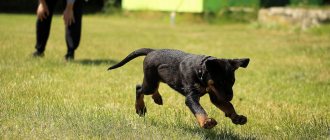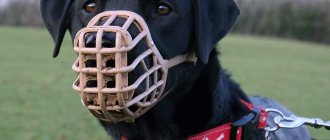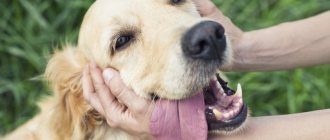Causes of enmity between dogs and cats
train a dog and a cat to live in an apartment or house
Dogs and cats are representatives of different families of the same order. Animals have specific behavioral characteristics and almost opposite types of temperament.
According to research, cats are not afraid of dogs. Aggression and attempts to avoid contact are effective ways to stop unwanted attention.
Cats have an independent character and love privacy. They value personal space and do not tolerate encroachments. Dogs, on the other hand, are considered social animals that seek company. Because of this, conflicts often break out between dogs and cats.
Cats and dogs also interpret body language differently:
- The cat regards light pushes of the skull and intense sniffing as an attempt to invade personal space. Such behavior causes aggression in the animal and a desire to grab the dog’s face.
- A dog's tail wagging means joy from an upcoming walk, meeting the owner, or seeing a toy. In this way, a cat expresses the highest degree of irritation and demonstrates its readiness to attack. Before a fight, the animal vigorously wags its tail and lashes its sides.
- Tight ears and a low head are interpreted by cats as a readiness to attack. In dogs, a similar pose means an admission of guilt. The dog understands that he deserves punishment and tries to appease the owner, demonstrating submission in advance.
- Cats purr to express the highest degree of satisfaction. The quiet, guttural growl of a dog means its readiness to attack and defend itself.
The dog unconsciously creates an intimidating impression on the cat. Frightened, she begins to run, awakening the hunting instincts in the dog.
What breeds of dogs get along well with cats?
In addition to companion dogs, many decorative breeds are classified as friendly four-legged dogs. Due to their modest size, they rarely terrorize cats and cannot cause them accidental harm with their weight during games.
Maltese (Maltese)
Small dogs that get along well with cats include Maltese dogs. These sociable and loving fluffies are devoid of aggression and easily make contact with other animals and strangers. This makes the Maltese very easy to steal.
INTERESTING!
In 2007, a Maltese named Trouble received an inheritance of $12 million from her owner, American businesswoman Leona Helmsley.
The main disadvantage of the Maltese dog is jealousy. It can encourage the dog to commit vile meanness, so be sure to ration your attention and do not play favorites in the family.
Pug
Funny and sociable, Pugs are not aggressive or jealous. They become attached to all family members and enjoy playing with other pets.
The only point worth paying attention to when keeping a pug and a cat together is the vulnerability of the former’s eyes. They are very easy to damage with claws, so as the plate grows, the “mustache” will have to undergo a forced manicure.
Pugs cannot stand being alone, so having a furry friend will be a big plus for them. Despite this fact, they do not suffer from obsession. It is not typical for pugs to follow their owner 24/7, begging for affection.
Labrador Retriever
The Labrador Retriever is completely devoid of aggression and is devoted to man to the depths of his soul. He gets along easily with other animals and never offends them.
Initially, Labradors were bred to find and fetch game, but eventually most owners began to use them as regular companions. Thanks to their developed intelligence and calm nature, they quickly remember commands and obey their owners unquestioningly.
Golden retriever
Like the Labrador, the Golden Retriever was bred for gun hunting. The character of these animals is largely similar, but there are some differences. Labradors are more energetic and active. Because of this, they can bother cats with their intrusiveness and excessive playfulness. This problem does not arise with golden retrievers, since, in addition to friendliness, their main qualities are calmness and self-control.
Thanks to their patience, representatives of this breed treat children very correctly. They forgive them any pranks and carefully protect them from dangers.
Beagle
The Beagle is a hound with a phenomenal sense of smell and a clear voice. He was bred to herd deer and hares, which is a very controversial fact for conflict-free cohabitation with “mustaches.” Despite this, most owners assure that in such a tandem the cat is usually the main instigator. If your pet has a peaceful character, then with the right introduction, a beagle can become his friend.
INTERESTING!
The US Department of Agriculture maintains a special beagle team that checks airport passengers for the presence of prohibited foods.
The main advantage of the beagle is its good nature. He loves the attention of others and understands the meaning of the word “family.” However, a beagle is quite capable of attacking a neighbor's cat, who has nothing to do with him.
Newfoundland
The powerful giant becomes firmly attached not only to the “mustaches,” but also to all other pets. He even builds warm relationships with parrots and hamsters, so you don’t have to worry about the safety of your cat next to your Newfoundland.
Representatives of this breed are used to rescue people on water. Trained dogs are capable of not only pulling a drowning person ashore, but also successfully towing a load weighing up to 700 kg.
“One of the characteristics of Newfoundlands is analytical thinking. Thanks to him, they rush to help someone in need without hesitation, without waiting for the appropriate command to be received.
Papillon (Continental Toy Spaniel)
Representatives of this breed show a special love for cats, since most of them are close to them in size. Thanks to their innate optimism and playfulness, Papillons very quickly find friends, involving them in their pranks and adventures.
Aggression on the part of friendly four-legged animals is the result of a lack of socialization and education. Other reasons for deviation of standard behavior include rudeness and psychological pressure.
Basset Hound
Basset Hounds are only patient with animals that are part of their family. They can drive and pursue everyone else out of instinct, but it is better to stop such behavior immediately.
These funny and clumsy hounds with an extremely low slouch only show their hunting skills when working. At home, they prefer to lie on the sofa and fill their bellies with a variety of goodies. Because of the latter, basset hounds very often gain excess weight, so their feeding regime and immediate diet must be strictly controlled.
Cavalier King Charles Spaniel
Dogs that love cats also include the Cavalier King Charles Spaniel. This shaggy fidget is on a wave of positivity 24/7 and is extremely dependent on the person. If there is a lack of attention, he can cause mischief and make a mess, so having a cat in the house is a reliable way to stop senseless destruction.
Leadership and the desire to dominate are alien to the Cavalier King Charles Spaniel. For this reason, he never offends other animals, but, on the contrary, tries to be friends with them. The Cavalier King Charles Spaniel has a special love for tactile contact, so attempts at a “milk step” on the part of the cat bring him real delight.
Bichon Frize
This miniature companion dog is the perfect family pet. The Bichon Frize is easy-going and always full of energy. He is in dire need of communication and easily makes new acquaintances, involving everyone in his funny games.
INTERESTING!
Numerous images of the Bichon Frize are found in the paintings of the Spanish artist Francisco de Goya.
Despite being sociable and friendly, the Bichon Frize loves to bark. If the cat is indifferent to this feature, then they will definitely be able to make friends.
Poodle
Elegant and pretty, poodles have high intelligence and a kind nature. Among the smartest four-legged animals, they occupy an honorable 2nd place, so they are easy to train even with a lack of experience.
Due to their non-aggressive nature, poodles are not suitable for guard duty, but they can become excellent friends for cats and playmates for children. Despite their exquisite appearance, representatives of this breed were bred for hunting. Due to their innate mobility and energy, they need not only regular, but also active walks.
Boston Terrier
Boston Terriers are a good choice for beginners. They are friendly, welcoming, pliable and completely non-confrontational. Both children and pensioners can cope with their upbringing.
Due to the lack of aggression and suspicion, Boston Terriers are completely calm about doorbells and do not bother their neighbors with their loud barking. They quickly form strong friendly bonds with representatives of the cat family. An attack on the “mustache” is possible only in a playful manner, but even in this case the dog will be reaction-oriented. If the cat is categorically against it and hits the four-legged prankster with his paw, the latter will quickly calm down and stop bothering him.
Yorkshire Terrier
The courage and playfulness of these kids is surprisingly combined with their intelligence and delicacy. Unlike most terriers, Yorkies, bred to catch rodents, quickly became common companions. They are friendly to other animals and easily find a common language with them.
Intelligent and loyal, Yorkies are easy to train and do not display dominance. Despite their small size, they are full of courage and are ready to defend their family without hesitation.
Shih Tzu
The Shih Tzu is another miniature companion dog, famous for its friendliness and sociability. She shows her affection to absolutely all family members: adults, children, other four-legged animals and, naturally, cats.
Thanks to her strong nervous system, the Shih Tzu is patient with the pranks of kids, but only until they hurt her. For outright bullying and violence, the animal will give back without further warning.
Bernese Mountain Dog
Despite its impressive size, the Bernese Mountain Dog is an ideal companion with an unusually peaceful character. He learns quickly and willingly follows commands. There are no problems in establishing relationships with mustachioed pets. If they don’t mind, the dog quickly becomes their friend.
INTERESTING!
In the mid-19th century, Bernese Mountain Dogs were used as draft power to pull milk carts.
Bernese Mountain Dogs are calm and phlegmatic. Increased curiosity and carelessness on their part are possible only in puppyhood.
Is it possible to make pets friends?
A kitten and a dog are friends for life
If after the first acquaintance of the animals the situation is not left to chance, then it is quite possible to accustom a dog to a cat. Correct behavior of the owner and taking into account the characteristics of the pets will help establish friendly relations.
How quickly animals become friends depends not only on the owner, but also on the age at which the pets were taken into the family and began to be taught to peaceful coexistence.
When to take action
Friends, let's be realistic: sometimes peaceful coexistence between pets is impossible. If a dog regularly tries to attack a cat, and the cat constantly scratches the dog, it is worth taking action.
For dogs, the owner is the authority, and a good way to keep him in line is to remind him of the rules of behavior. Training will help with this. If you have already completed it, it is worth repeating or teaching new commands so that the authority of the owner prevails over instincts. But you need to be extremely careful and understand that at some point you will not be around and the animal may react to the cat.
When you leave home, be sure to place your pets in different rooms or place the dog in an enclosure.
How to make friends with kids: kitten and puppy
The ideal option is when both pets were taken into the house as babies at the same time. Animals, only separated from their mother, will begin to look for understanding and support in each other. Due to their age, puppies and kittens cannot sleep alone and begin to instinctively cuddle each other in their sleep. Together they adapt faster and easier to their new home.
Also, a puppy and a kitten will be brought together by joint pranks and games. The kids will explore the world around them together, which will help them make friends.
Even if at the first meeting the puppy and kitten show dissatisfaction with the presence of their neighbor, it will disappear after a few hours. After sniffing, the kids will quickly get used to it and make friends.
Important! Left alone, the kitten and puppy can get carried away with games and mischief. Therefore, children cannot be left to their own devices for a long time.
“No” to punishments and emotional pressure!
Animals should not be punished in the presence of other animals. This may hurt their situation. For example, a dog defecated not in the designated place, but on the floor in the middle of the room.
Under no circumstances should you scold or make sudden movements in front of your cat. There are many other ways to help overcome such “embarrassments.” And these methods are much more effective.
The question of how to make friends between a cat and a dog in an apartment will never be resolved if one of the animals has been scolded or punished at least once in the presence of the other.
How to make friends between an adult dog and a kitten, 8 rules for a peaceful neighborhood
Adult dogs are often friendly towards kittens. But increased attention can frighten the baby.
To ensure that the introduction of pets goes smoothly and without damage to the kitten’s psyche, it is advisable to pay attention to the following points:
- Exchange of smells. Before the kitten arrives, it is recommended to give the dog something that smells like the baby, so that his appearance is not regarded as a threat. At first, it is better to isolate pets in separate rooms, organizing daily meetings for them. This makes it easier for animals to become accustomed to each other’s smell and make friends.
- Adding cat scent. If the dog is aggressive or older, a few weeks before the expected arrival of the kitten, it is recommended to use special pheromones that emit a cat scent. This way the dog will stop stressing and will accept his new neighbor more loyally.
- Separate feeding. Dogs are jealous of their own food and in order not to heat up the situation, it is advisable to separate the eating area. Subsequently, the old-timer is recommended to give food first.
- A safe place for a cat. It is advisable for each pet to have its own corner. It is recommended to place the kitten's place higher so that the dog cannot reach it. If the owner does not take care of this issue, the animals will deal with the rest areas on their own, which will lead to a deterioration in relations. Prepare “safe places” where your cat can run and hide from your dog when he feels threatened .
- Obedience training. Your dog needs to be taught that chasing cats is not acceptable behavior. Teach your dog basic commands such as sit, stay and down. Then it will be easier for you to reconcile the cat and dog.
- Interaction control. You should only allow interactions under your supervision, especially in the first few weeks after your cat and dog have just met.
- Desensitization. The goal of desensitization is to reduce your dog's reaction to your cat through constant exposure. Separate them temporarily with a fence so they can see each other and sniff, but try to distract the dog's attention with toys and food so that the dog is not fixated on the cat. Over time, the dog will lose interest in cats.
- You can't scold a dog too much. The fact is that the dog may understand that he is being scolded because of his relationship with the cat and will pursue the cat even more. Try to encourage a positive attitude between them.
Desensitization of dogs and cats
You cannot scold or punish a dog for aggression. It is enough to strictly explain to the animal that it is not good to offend the baby. An adult dog usually does not want to harm the baby, but it is better not to take risks. The owner must equally distribute attention between the animals and organize a joint game.
Why introduce pets
If you simply bring in a new dog and leave him with an animal that feels like the boss of the house, it will be stressful for both of them. As you know, stress can provoke the development of many diseases, including baldness or urinary incontinence. We wrote more about stress in cats and dogs in this article.
In addition, the dog can bite the cat. And often the opposite happens, when a cat, in defense, rushes at the dog. This can result in claw cuts to the eyes and other injuries.
Therefore, proper introduction of pets is, first of all, a matter of health and safety.
How to make friends between an adult cat and a puppy
Adult cats often perceive puppies aggressively. To protect the new resident from the sharp claws of the old-timer, the animals are initially isolated in different rooms.
Then the cat will not scratch the curious, playful puppy, who will probably become excessively active.
It is recommended that animals have separate places for feeding and sleeping. The cat will quickly get bored with the puppy’s pestering and will want to retire. Therefore, the owner must regulate the time the pets communicate and limit it.
If personal boundaries are violated, the cat will hiss for a long time at the new neighbor. If the puppy does not climb into her bowls, bed and tray, she will quickly get used to his presence.
What to consider before getting a new pet
- You should prepare everything you need : food, bowls, tray, collar, toys, care products, etc. We have detailed articles for future owners on keeping cats and dogs.
- Make sure that the new pet is completely healthy and will not pose a threat to the animals already living in the house. If you picked it up from the street, it is better to quarantine for at least a month. If a newly admitted person has an infection, everyone in the household can become infected. Therefore, you must take your pet to the veterinarian. It is equally important to carry out deworming, treatment against ectoparasites and vaccination.
- If a pet already living in the house reacts too aggressively to cats or dogs, you should think about whether you should get someone else at all.
How to make friends with adult animals
How to make friends between an adult dog and a cat
Accustoming adult animals to live together is very difficult, but quite possible. At first, the dog will begin to perceive the cat as an object for play or hunting.
Therefore, it will take a long time to separate the animals. If it is not possible to place your pets in separate rooms, it is recommended to buy an indoor aviary.
When first meeting the dog, it is advisable to keep the dog on a leash and muzzle. The animals will probably limit themselves to visual contact and refuse to sniff. You should not let the dog get close to the cat, otherwise the cat will decide that it is being attacked and will begin to defend itself.
It is recommended to organize further communication between pets at a distance to avoid a possible fight. If conflict between animals cannot be avoided, it is advisable to tie the dog and force it to sit on command. It is recommended to calm an angry cat with a voice and gentle stroking. Such actions will help relieve tension and resolve conflict.
To accustom a dog to a cat, it is recommended to reward any manifestation of goodwill with a treat. But you can feed animals in one place only after good neighborly relations have been established between them. Competition for food can cause serious conflict.
Jealousy
Jealousy is a very vivid destructive feeling that can push not only a person, but also an animal to the most terrible actions.
- Cats are more jealous than dogs, and some types of cats are also very vindictive by nature.
- Jealousy can be recognized by the following behavior patterns: The animal suddenly began to hide in hard-to-reach places and disappear from view, which indicates its desire to encourage a person to search.
- It is also a sharp manifestation of aggression towards another pet when it is in the arms of the owner, and refusal to eat and defecate due to stress due to jealousy.
What not to do
Inexperienced owners, trying to accustom a dog to a cat, make serious mistakes.
To quickly make friends with your pets, you should not make the following mistakes:
- It is prohibited to put pressure on animals , forcing them to communicate.
- You cannot give one animal more attention than the other. Some owners deliberately single out their pet. Others unknowingly neglect one pet. As a result, the animal feels like an outcast and begins to be jealous, provoking conflicts.
- In the event of a quarrel, it is prohibited to punish the initiator of the fight. At the initial stage of accustoming a dog to a cat, conflicts will inevitably break out between animals. The owner must notice the emerging quarrel in time and extinguish it. In a cat, swearing causes a desire to take revenge; in a dog, a long-term fear arises.
- It is prohibited to have animals in cramped living conditions. Each pet should have its own resting place and enough space to move around.
- It is prohibited to leave animals alone. Attacks of aggression often come out of nowhere and calm can quickly escalate into a fight. Animal behavior is unpredictable and the owner must control the pets.
Dogs are more active and sociable. To prevent them from pestering their furry neighbor, they should not be limited in walks and active games.
We recommend reading:
- We teach the dog to stop picking up everything on the street
- Training or education of dogs
Additional sources of information:
Tips on how to make a cat and dog become friends
Who is the head in this house
Depending on which pet you got first and its age, there may be nuances when you first meet. Let's consider the possible options.
How to bring a kitten home if you have a dog
This is usually one of the simplest options. The kitten has no negative experience with animals yet; he is open to the whole world and very curious. Therefore, he can easily let himself be sniffed by the dog, and this is one of the most important moments in the first acquaintance.
But first things first:
- Before meeting, you need to let the kitten get comfortable. Temporarily allocate him a separate room in the apartment, where the dog will not have access. Place his tray, bowl, scratching post, sleeping place, etc. there. Let the baby go everywhere on his own.
- At the second stage, the carrier with the kitten must be brought into the room where the dog is. Let the dog come and sniff. If the dog shows aggression, use your voice to rein in the dog; if it behaves calmly, reward it with treats.
- If sniffing the carrier was successful, you can gently let the dog sniff the kitten from your hands. For safety reasons, it is better to do this together: one person holds the kitten in his hands, the second brings the dog into the room, holding it on a leash. In case of barking or sudden jerks from the dog, you can slightly pull the leash, giving a strict command with your voice. If the dog peacefully sniffs the kitten or sits calmly next to it, do not forget to give encouragement.
- Do not leave pets alone unattended.
- When feeding, make sure that the kitten does not climb into the dog’s bowl.
- Pay more attention to the dog: it should not feel left out.
How to introduce an adult dog to an adult cat
Since these animals already have experience of interspecies communication, including negative ones, their reaction to a new pet can be unpredictable.
But the basic principles of dating are the same:
- Give your new pet a separate room and only let it out there.
- Trim your cat's claws. How to do it yourself, watch our video. To avoid injury, it is better to disarm scratching paws in advance.
- Introduce the tailed “owner” to the smell of the new pet by placing his things on the bed or near the bowl.
- Let your pets sniff each other's territory. While you are walking your dog, allow your cat to leave her room and wander around the apartment. Likewise, when there is no cat, let the dog go into the cat's room and sniff everything there.
- Place the animals' bowls within sight, but in different rooms, so that at the initial stage there is a barrier in the form of a door. For example, you can place a dog’s bowl near the door to the “cat’s” room. After some time, carefully open the door slightly, observing the reaction of the animals.
First meeting:
- Prepare a shelter for the cat (house, carrier, box) that will be inaccessible to the dog.
- Relax your pets before meeting them. The dog should be fed, taken for a walk, and ideally slightly tired after active games. It is also better to feed the cat, pet it, and you can give it a sedative. We provided a list of safe sedatives for cats in this article.
- On neutral territory, place the cat in a carrier, box, or other shelter where she feels calm.
- Put a leash on the dog (and a muzzle if necessary), talk to it affectionately, and go into the room with the cat. Let your dog sniff the cat carrier and reward him for calm behavior. For any type of aggression, lightly pull on the leash and give a stern command with your voice. The first meeting should ideally not last more than a couple of minutes.
Further communication:
- Have meetings as often as possible. Be sure to reward your dog for calm behavior. If the animal's reaction is normal, organize an introduction without using a carrier, by holding the cat in your arms.
- If any of the pets become too agitated, end the meeting.
- Limit your dog's access to the cat room. In the first stages, it is important not to allow your pets to interact without your participation in order to avoid a negative experience.
How to properly introduce an adult cat to a puppy
- Make sure that the cat has somewhere to hide or climb: you need a place where the puppy cannot reach her.
- Give your puppy a separate room in which all his belongings will be located.
- When you first meet him, hold the puppy (you can pick him up) so that he doesn’t scare the cat with his activity.
- When your puppy tries to chase the cat, distract him by switching him to another activity.
Otherwise, the advice is the same as above.
Differences in habits
A cat and a dog have different attitudes towards the society of their own kind. Since ancient times, cats have been distinguished by their independent character and value peace and solitude. Dogs are more likely to seek constant company. Previously, the ancestors of the canine family gathered in packs.
Cats are inherently antisocial animals. In their natural habitat, they hunt alone and jealously defend their territory. Representatives of the cat family converge with other individuals exclusively during the breeding season. If the owner did not help the pets when introducing them, it will be difficult for them to get along in the same apartment in the future. You can find out which dog is best to have in an apartment in this article.
Expert opinion
Anna Abramenko
An avid dog lover. Experience in veterinary medicine since 2009.
Ask a Question
This is not to say that all cats are selfish. There are many breeds whose need for communication is as high as that of dogs. If there are already animals in the house, it is recommended to pay attention to these species, which are distinguished by their good-natured disposition.











